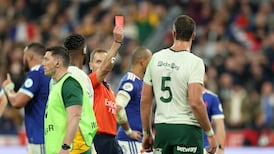This week the Springbok assistant coach Mzwandile Stick sat in the media room in the Radisson Hotel in south Dublin far from pleased with recent rulings.
Stick’s complaint was that his team were being unfairly treated by officials.
He was fuming and bewildered over the red cards issued to South African forwards Lood de Jager and Franco Mostert in their recent games against France and Italy.
De Jager was given a permanent red card for his dangerous tackle on French fullback Thomas Ramos in the Stade de France, with Mostert handed his for a similar hit on Italy’s Paolo Garbisi in Turin.
The Counter Ruck: the rugby newsletter from The Irish Times
Ireland’s improving lineout statistics bode well for South Africa Test match
Andy Farrell comes to Sam Prendergast’s defence as he highlights outhalf’s qualities
Springboks seeing red over recent red cards – and it’s an eyesore for spectators too
The general point Stick was making was that in trying to be safe and protect players from head injury, rugby had instead become confusing and difficult to understand.
He added that, similarly judged, there were five other incidents that could have been red cards too.
To a degree the complaint was taken as part of the Springbok mentality of saying out loud what other teams keep to themselves. They have a confrontational attitude and don’t tend to sit back from issues that directly affect their players.
Other sides bite their lip and adopt an attitude of saying little that could get them into trouble with the authorities, or hand grievances to officials who in the future are likely to be appointed to their games.
[ South Africa fuelled for Ireland Test by their unrivalled sense of grievanceOpens in new window ]
But Stick’s complaint rang true because the law around tackling has become one of the eyesores of the game, and hugely consequential for the outcome of matches.
For both locks, De Jager and Mostert, the officials, Angus Gardner and James Doleman, judged on the pitch and under pressure that their actions were “always illegal”, meaning that a yellow card and referral to the foul play review officer, TMO Bunker, was not needed.
Both players left the pitch and were not replaced by another player after 20 minutes.
De Jager was handed a four-game ban and on Thursday lost his appeal, while on Wednesday Mostert was exonerated by an independent disciplinary committee.

This is what the committee of Stephen Hardy (Australia), Ofisa Tonu’u (New Zealand) and Jamie Corsi (Wales) decided on the Mostert tackle: “The evidence established that the initial contact made by the player was directly to the shoulder of Italy 10 [Garbisi] with there being ‘daylight’ between the shoulder contact and head/neck area of Italy 10.
“Head contact was then found to have occurred but was found to be secondary to the initial shoulder contact and made with much lower force and without the requisite level of ‘danger’ required under World Rugby’s Head Contact Process to make the offending reach the red card threshold.
“The red card has accordingly been dismissed and will be expunged from the player’s disciplinary record.”
[ South Africa survive early red card to see off Italy in TurinOpens in new window ]
This is what Doleman said to Springboks captain Siya Kolisi and Italy’s captain Ignacio Brex during the match: “The TMO has confirmed that there is clear head contact. The TMO, along with us, has confirmed that it’s an always illegal action because number five does not attempt to wrap, his arm is behind him.
“Therefore, we don’t apply any mitigation. We acknowledge there is another tackler [Ethan Hooker], it doesn’t apply to an always illegal action, it’s going to be a permanent red card.”
In coming to their decision the independent committee conducted a detailed review of “all available evidence, including all camera angles and additional evidence and submissions”.
In other words, their conclusions were arrived at by using “additional evidence” that may not have been available to the referee on the day.
What doesn’t help with clarity around tackling high and dangerous play is that different laws apply depending on what level of rugby spectators are watching.

A small digression, but germane, is that in August the IRFU committed to keeping the legal tackle height below the level of the sternum following the completion of the two-season tackle behaviours trial across club rugby.
In Test rugby the tackle height is governed by Law 9.13, where dangerous play is tackling above the line of the shoulder.
Last week Lansdowne had five Leinster-capped players in their starting line-up, including Ireland international Max Deegan, who had to adjust his tackling from shoulder to the lower sternum level. What could go wrong there?
The Mostert decision was essentially a second band of jurists, the three lads on the independent committee, overturning the first set of jurists, the referee and his assistants.
It leaves the rest us wondering what’s going on.
Whether a tackle is legal appears to turn on infinitesimally dissected body movements and contact areas, where pitch decisions are changed based on microseconds of time and motion.
All of it is far removed from the realities of playing the game.
Stick had every right to become infuriated about the calls, which left his team playing with 14 men.
He was correct to highlight what a lottery the on-pitch decisions and the appeals have become. Furthermore, he wasn’t wrong to let people know that because of it the world champions and number one team in the world are disaffected.
If coaches and players are left incensed and confounded over dangerous tackling, what chance have fans got in the stadium or on the sittingroom couch of being anything less than baffled?

















